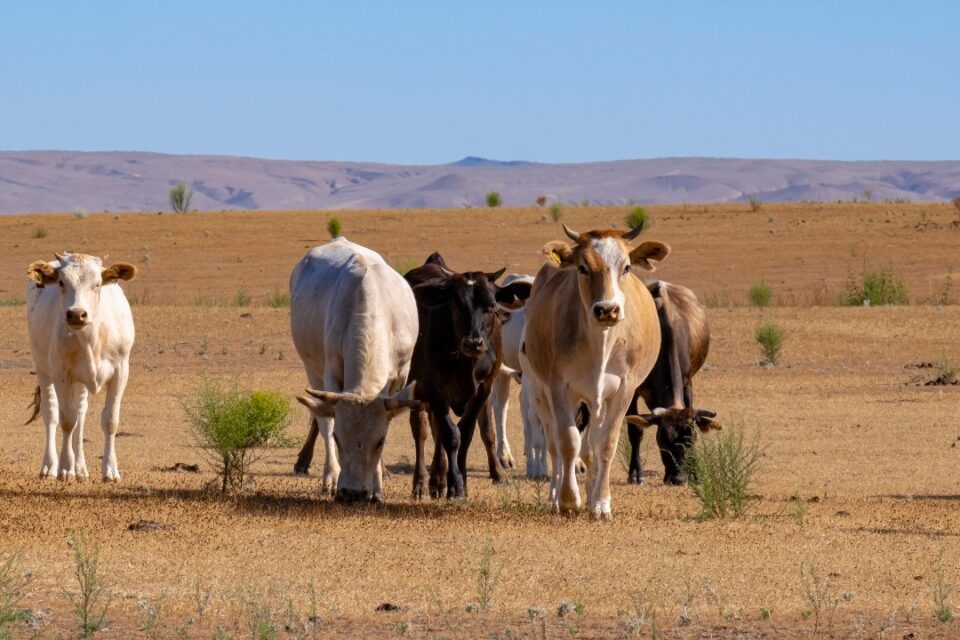As part of the Basin Diagnostic of the Shabelle Basin in Somalia, we looked at the extensive dryland area outside the riparian zone. The prevailing farming system here is the pastoralist system. Livestock are grazed on arid and semi-arid pastures that utilize rainfall that cannot be used for crop production or other productive purposes. Only a fraction of rainfall over the grasslands will reach surface water bodies or the groundwater system. The rest represents low-value water that evaporates or is used to grow pasture. Livestock are efficient in making productive use of this low-value water. Because of their mobility, pastoralists move between different seasonal pastures across the region—following local rainfall and pasture. This setup allows for effective use of scarce natural resources.
Livestock is the leading economic sector in dryland areas while it is critical to achieve food security in this zone. In Somalia, for instance, average per capita consumption of milk is 330 liters per year. It is 22 kg for meat (Sandstrom, 2021). These figures emphasize the sustained importance of the pastoralist system. Improving livestock productivity, therefore, is a key policy objective in countries in the dryland zone.
The potential for improving livestock productivity is substantial. It comprises three main elements: 1) better animal management strategies, 2) improving the value chain, and 3) improved land and water management.
This blog post will only focus on the latter: how to make better use of the natural resource base to strengthen the pastoralist livelihood system.
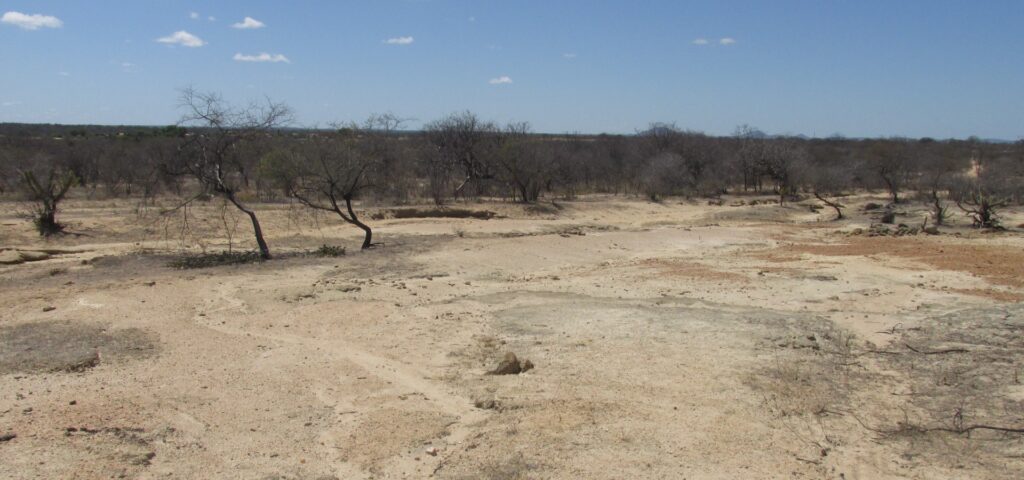
Land Degradation
While pastoralism is generally resilient and well-adapted to make use of marginal lands, it is vulnerable to drought and land degradation. For many years, large areas of grasslands in the world—including Somalia and the wider East African region—have been gradually degrading while climate change is reportedly increasing the frequency and intensity of drought events.
This may have long-term impacts on the natural resource base on which the pastoralist system depends. Since drylands are fragile, land degradation is not easily reversed, and it will be difficult to recover carrying capacity once it is lost. Thus, intensified drying because of climate change and associated land degradation will reduce the quantity and quality of forage and will impair the capacity of the land to sustain livestock.
| Green water The portion of rainfall in the pastoralist zone that does not reach the river or groundwater system is substantial. This water resource is distributed and not available for use outside its immediate vicinity. It is separated into transpiration and evaporation. Transpiration is the portion of rainfall that is used to produce biomass while evaporation returns to the water cycle without productive use. In dryland areas, transpiration primarily originates from direct rainfall that is stored as soil moisture and used to grow fodder. The relation between transpiration and biomass production is essentially linear for a given crop (or grass), climate, and nutrient status. Thus, increasing transpiration at the expense of evaporation would proportionally increase fodder production. High transpiration and low evaporation in a landscape suggests permanent vegetation cover throughout the year. By contrast, a high evaporation-transpiration ratio points to barren lands. Hence the high proportion of evaporation compared to transpiration in the pastoralist zone in Somalia hints at a degraded landscape where large areas are without ground cover for some parts of the year. |
Wasting Scarce Rainfall
Average annual rainfall over the dryland area in the Shabelle basin in Somalia amounted to 427 mm (2008-2020). This is a significant water resource. Some 175 mm of this rain—thus more than 40%—is lost to evaporation (FAO WaPOR). Evaporation is rainfall that returns to the hydrological cycle without productive use. It represents a huge waste of scarce water resources.
The ratio of annual evaporation to precipitation in the drylands in the Shabelle basin in Somalia is presented in the below table. Data originate from FAO WaPOR.
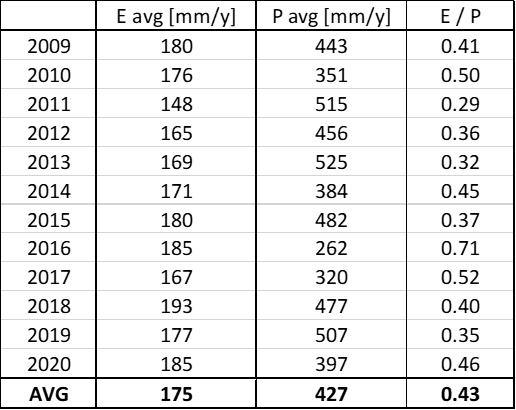
There is an almost linear relation—with a negative slope—between the percentage of rainfall that evaporates and total precipitation. More than 70% of rainfall was lost without productive use in the driest year, while this figure drops to about 30% in a wet year.
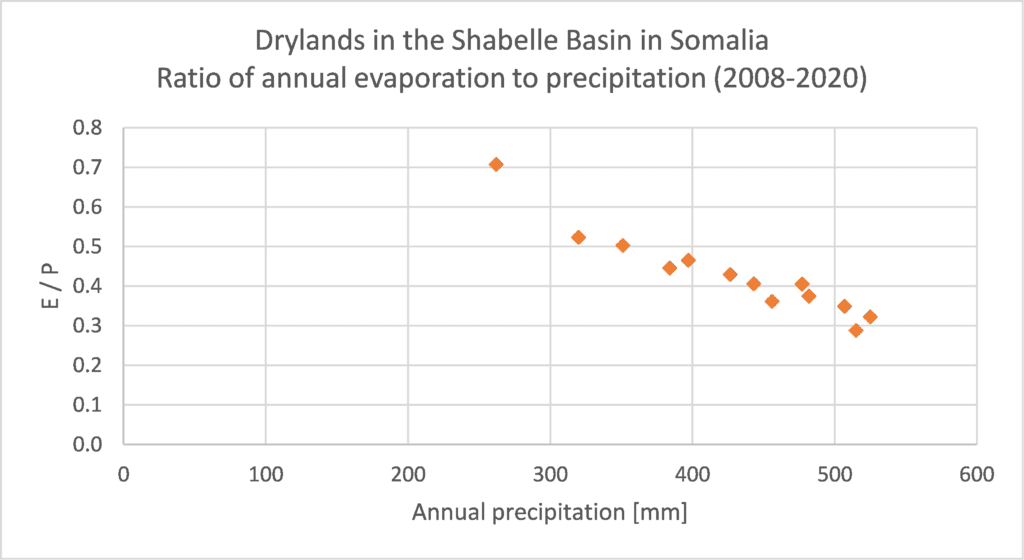
This is a typical signature for a degraded landscape where very little vegetation is left at the end of the dry season. Hence at the onset of the rainy season, evaporation dominates in the absence of vegetation. But a few weeks after the occurrence of a large precipitation event—when vegetation emerges or recovers—most rainfall is used for transpiration, with attendant biomass production.
Dryland Restoration
Dryland restoration is exceedingly difficult because if involves a very fragile ecosystem that is subject to “the tragedy of the commons”. These are communal lands that are easily over-exploited because of uncoordinated grazing by individual herders—specifically in periodic drought years. Nevertheless, age-old traditional grazing rules and practices exist that aim to find a balance between the natural resource base and its sustainable use. It is probable that climate change and desertification have altered this equilibrium, and that grazing rules and land-use practices must adapt.
The below figure presents a conceptual diagram on how to restore drylands. In essence it aims to increase ‘productive’ transpiration at the expense of ‘non-productive’ evaporation. It is noted that dryland restoration very much depends on local factors such as (micro) climate, soil depth and structure, relief, wildlife, and grazing practices. In addition, dryland restoration is a long-term undertaking and quick results should not be expected. Nevertheless, the schematic facilitates a structured discussion on this challenging subject.
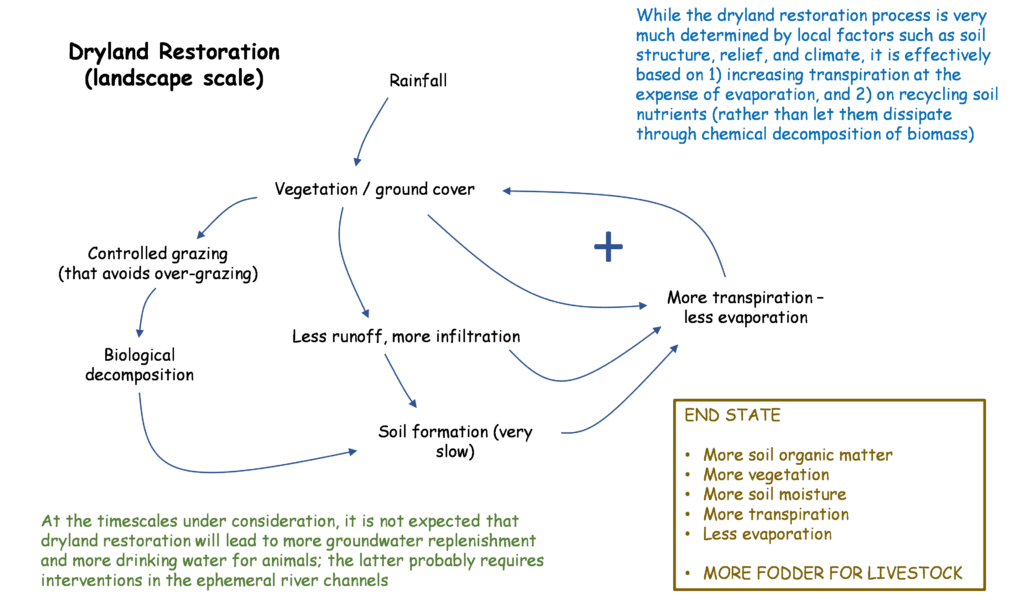
Increasing groundcover will reduce direct runoff and evaporation and leads to more infiltration of rainfall into the soil. This, in turn, leads to more biomass production. It is a positive feedback loop in which vegetation leads to more vegetation. However, there is a complicating factor. Soils in tropical dryland areas are typically poor in terms of nutrients because of leaching and high temperatures that lead to chemical decomposition of biomass. The latter causes scarce nutrients to dissipate rather than to recycle and build soil organic matter. It points to the importance of controlled grazing—either by livestock or by wildlife—where biomass is recycled through biological decomposition. Undisturbed natural grasslands in the semi-arid zone have evolved in a symbiotic relationship with large herds of moving herbivores, which perpetuated a cycle of vegetation growth and biological decomposition. Mimicking such system through pastoralism is at the basis of the ‘holistic management strategy’ introduced by Allan Savory. He asserts that overgrazing is equally destructive as the absence of grazing. Both accelerate desertification in the long term.
Allan Savory’s holistic management strategy for livestock can also be referred to as “plant stimulating grazing system” (adapted from Natalie Fleming)
Dryland restoration at landscape scale is a massive undertaking that, therefore, cannot be based on human interventions alone and will require an approach that mimics nature. Using livestock management practices that resemble the movement of ancient herds of herbivores that have created this type of landscape is something worth exploring. In addition, it may very well conform with the intricate and long-standing traditional pasture management systems that have been employed by the pastoralist people in this environment.
REFERENCES
FAO. 2020. WaPOR database methodology: Version 2 release, April 2020. Rome. https://doi.org/10.4060/ca9894en
Xiangmin Sun (et al), Evapotranspiration partitioning in dryland ecosystems: A global meta-analysis of in situ studies, Journal of Hydrology, Volume 576, September 2019, Pages 123-136
Sandstrom, K. 2021, Overview and Outcome of Five Water Resources Management Options for Somalia, MoEWR
Note: The latest IPCC report has instilled a new sense of urgency in climate adaptation and climate solutions. Since the soil serves as a huge carbon sink, dryland restoration that increases ground cover and soil organic matter also contributes to taking CO2 out of circulation.
This carbon sequestration function was emphasized in a recent interview with Mr Gary Nairn, Chairman of the Mulloon Institute, as published in a press release. Some excerpts:
“Few people are aware that soil contains two to three times more carbon than the atmosphere, and that it is possible to absorb the world’s annual anthropogenic emissions in our soils.”
“Key to carbon sequestration is water, and a hydrated landscape will speed up carbon sequestration.”
“For example, soil organic matter (SOM) has increased by up to 129% over the past ten years as a result of our work through the catchment-scale Mulloon Rehydration Initiative (MRI).”
“SOM is a lead indicator for soil health and soil carbon. We have proven through our research, that when we fix water cycles on farmers’ land, we can retain more water in the soil, increase vegetation cover, sequester carbon and improve long term profitability.”
“In particular, the IPCC Report highlights a future of less rain overall but more intensive events, risking flooding and erosion. Our work is geared specifically towards making our landscapes more resilient to such events.”
